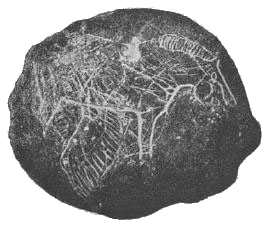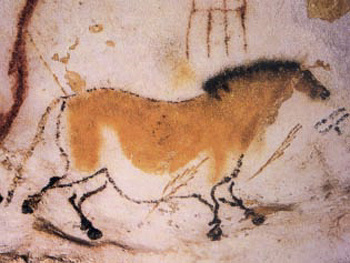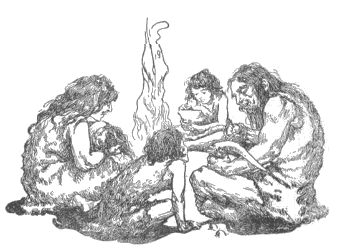Stone-Age Internet
October 27, 2011
One thing that serves to distinguish
man from other
species is his use of
tools. At one time, it was believed that only man was a tool user, but there are numerous examples of
tool use in other species.
Man's first use of
stone as a tool started in the
Lower Paleolithic, about 2.5 million years ago. The Lower Paleolithic was the start of the
Stone-Age. This age of man in which stone was the sole tool continued up until 5,000 years ago. At that time,
metallurgy of
copper and its alloy,
bronze, was developed, ushering in the
Bronze Age.

A horse of a different color.
Paleolithic rock drawing, from Theo van Doesburg, "Drie Voordrachten over de Nieuwe Beeldende Kunst Verscheen," 1919, p. 65
(Via Wikimedia Commons))
Other traits that distinguish man are his
sociability and use of
language. Communication of ideas in the Stone Age was mostly by demonstration, including primitive images that may have conveyed some information (see image above). There is
conjecture that
language developed in the Middle Stone Age. In any case, physical contact between individuals was necessary to convey information.
Modern human behavior, such as development of
complex symbolism and
technologies, started to show in our Stone Age ancestors about 45,000 years ago. A 2009 paper by Adam Powell, Stephen Shennan and Mark G. Thomas offered evidence that
population density and
migratory patterns were responsible for this change, not any increased
cognitive capacity.[1] The extended population allowed a stable information flow throughout the human populace so that, in effect, everybody didn't need to keep
reinventing the wheel.
When a
physicist reads something like that, he realizes that what's proposed is a
percolation model for
diffusion of
information. The evidence for a
sharp phase transition from dumb brute to cave painter is further evidence that percolation is a reasonable model.

An image of a horse from the Lascaux caves.
The Lascaux painting are estimated to be about 17,300 years old, which places them in the Upper Paleolithic.
(Via Wikimedia Commons))
In a simple two-dimensional percolation model, the plane is divided into a checkerboard of cells.
Agents can randomly populate these cells, and they can be constrained to communicate only with agents on adjacent cells. It's fairly obvious that a small density of agents doesn't allow the possibility of communication from one corner of the plane to another. However, at a
critical density, information flow from one side of the plane to the opposite side is allowed.
Such a percolation model for information diffusion in the Stone Age was examined in a recent posting on the
arXiv Preprint Server by four
Palestinian physicists, M.A. Sumour, M.A. Radwan, M.M. Shabat and Ali H. El-Astal.[2] In the case of Stone Age communication, the
checkerboard is populated by campsites of small human groups. The cells are separated by a reasonable distance for casual communication, about a day's walk, or two.

Romanticized vision of a Stone Age family around a campfire.
(From "The Cave Boy of the Age of Stone," by Margaret A. McIntyre).[3])
Since the standard percolation model is just concerned with the
connections between cells, the research team incorporated the idea that there must be enough time for information to travel from one group to another by assuming that the data has a lifetime. In the mechanics of a percolation computation, this would be a limit on the number of
iterations in the model.[2]
In a standard percolation model, only 0.593 of the cells need to be filled to allow connection from one corner to another. The results in the arXiv paper show that adding the additional constraint of the lifetime of information means that the filled fraction of cells needs to be much larger. Stone Age civilization would only blossom when the human population was quite large.[2]
One factor that might reduce the required cell occupancy is the idea that humans do not stay in a single place, but they tend to move about. Such movement, which the arXiv authors characterize as
annealed, rather than
quenched disorder, might facilitate information transfer.[2]
References:
- Adam Powell, Stephen Shennan and Mark G. Thomas, "Late Pleistocene Demography and the Appearance of Modern Human Behavior," Science, vol. 324, no. 5932 (June 5, 2009), pp. 1298-1301.
- M.A. Sumour, M.A. Radwan, M.M. Shabat, Ali H. El-Astal, "Statistical physics applied to stone-age civilization," arXiv Preprint Server, October 13, 2011.
- Margaret A. McIntyre, "The Cave Boy Of The Age Of Stone," Harrap (London, Not Dated, Certified Public Domain by Archive.org).
Permanent Link to this article
Linked Keywords: Human; man; species; tool; tool use in other species; rock; stone; Lower Paleolithic; Stone Age; metallurgy; copper; bronze; Bronze Age; Theo van Doesburg, "Drie Voordrachten over de Nieuwe Beeldende Kunst Verscheen; Wikimedia Commons; sociability; language; conjecture; language developed in the Middle Stone Age; Man and His Symbols; Carl Jung; complex symbolism; technology; population density; human migration; cognition; cognitive capacity; reinventing the wheel; physicist; percolation model; diffusion; information; sharp phase transition; Lascaux caves; Upper Paleolithic; intelligent agent; percolation threshold; arXiv Preprint Server; Palestinian; checkerboard; The Cave Boy of the Age of Stone; Margaret A. McIntyre; graph; connection; iteration; simulated annealing; quenched; randomness; disorder.